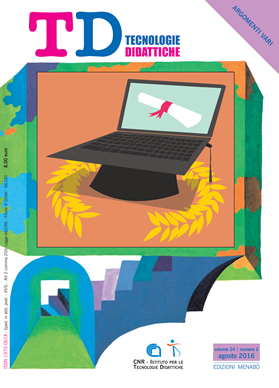Social network sites as tools of social inclusion for people with disability
Main Article Content
Abstract
Despite the growing popularity of social network sites (SNS) among several sectors of the population, few studies have investigated the potential that these digital environments offer as tools of social inclusion for disabled people. This study presents the results of an online survey administered to people with disability in Italy in order to establish what SNS they mainly use and for what purposes, and to investigate the accessibility issues users experience. We collected 144 complete responses and primarily used descriptive statistics to illustrate the characteristics, self-reported behaviours, and experiences of use. The results reveal that the respondents mostly use Facebook, that they engage more with their nondisabled friends than with disabled ones, and that they mainly perceive SNS as an opportunity to find old friends and as a means for keeping updated about news and events related to their disability. Lastly, the most commonly reported problems in accessing and using SNS content are general problems of accessibility and Internet access. The limitations of the study are provided, along with indications for further research.
Article Details
Section
Authors who publish with this journal agree to the following terms:
- Authors retain copyright and grant the journal right of first publication with the work simultaneously licensed under a Creative Commons CC BY 4.0 Attribution 4.0 International License.
- Authors are able to enter into separate, additional contractual arrangements for the non-exclusive distribution of the journal's published version of the work (e.g., post it to an institutional repository or publish it in a book), with an acknowledgement of its initial publication in this journal.
- Authors are permitted and encouraged to post their work online (e.g., in institutional repositories or on their website) prior to and during the submission process, as it can lead to productive exchanges, as well as earlier and greater citation of published work (See The Effect of Open Access)
References
Agenzia Europea per lo Sviluppo dell’Istruzione degli Alunni Disabili (2013). Nuove tecnologie per l’inclusione - Sviluppi e opportunità per i paesi europei. Odense, Danimarca: Agenzia Europea per lo Sviluppo dell’Istruzione degli Alunni Disabili. Retrieved from https://www. european-agency.org/sites/default/files/ ICT_for_Inclusion-IT.pdf
Baroni, F., & Lazzari, M. (2013), Tecnologie informatiche e diritti umani per un nuovo approccio all’accessibilità. Italian Journal of Disability Studies, 1(1), 79-92.
boyd, d. m., & Ellison, N. B. (2007). Social Network Sites: Definition, History, and Scholarship. Journal of Computer-Mediated Communication, 13(1), 210-230.
Bundon, A., & Clarke, L- H. (2015). Unless you go online you are on your own: blogging as a bridge in para-sport. Disability & Society, 30(2), 185-198.
Davies, D. K., Stock, S. E., King, L. R., Brown, R. B., Wehmeyer, M. L, & Shogren, K. A. (2015). An interface to support independent use of Facebook by people with intellectual disability. Intellectual and Developmental Disabilities, 53(1), 30-41.
Delogu, C., Carela, G., Maslova, A., & Nicolussi, R. (2012). Accessibilità e usabilità dei social network. La Comunicazione - Note, Recensioni & Notizie, 35-42. Retrieved from http://www.isticom.it/documenti/rivista/ rivista2012/2012_04_35-42_accessibilita_ social_network.pdf
Ellison, N. B., & boyd, d. m. (2013). Sociality through Social Network Sites. In W. H. Dutton (Ed.), The Oxford Handbook of Internet Studies (pp. 151-172). Oxford, United Kingdom: Oxford University Press.
Ferlino, L., & Manca, S. (2015). Social network e disabilità. Risultati di un’indagine italiana. Rapporto tecnico ITD-CNR, Dicembre 2015. Retrieved from https://www.researchgate.net/ publication/287997626_Social_network_e_ disabilita_Risultati_di_un%27indagine_ italiana
Friesen, N., & Lowe, S. (2012). The questionable promise of social media for education connective learning and the commercial imperative. Journal of Computer Assisted Learning, 28(3), 183-194.
Hampton, K. N., Sessions Goulet, L., Rainie, L., & Purcell, K. (2011). Social networking sites and our lives. Pew Research Center’s Internet & American Life Project. Retrieved from http://www.pewinternet.org/2011/06/16/ social-networking-sites-and-our-lives/
Holmes, K. M., & O’Loughlin, N. (2014).The experiences of people with learning disabilities on social networking sites. British Journal of Learning Disabilities, 42(1) 3-7.
Kent, M., & Ellis, K. (2015). People with disability and new disaster communications: access and the social media mash-up. Disability & Society, 30(3), 419-431.
Lee, S. M., Hong, S.-G., An, D.-H., & Lee, H.-M. (2014). Disability users’ evaluation of the web accessibility of SNS. Service Business, 8(4), 517-540.
Manca, S., & Ranieri, M. (2013). Is it a tool suitable for learning? A critical review of the literature on Facebook as a technologyenhanced learning environment. Journal of Computer-Assisted Learning, 29(6), 487-504.
Na, J., Kosinski, M., & Stillwell, D. J. (2015). When a New Tool is Introduced in Different Cultural Contexts: Individualism-Collectivism and Social Network on Facebook. Journal of Cross-Cultural Psychology, 46(3), 355-370.
Notley, T. (2009). Young People, Online Networks, and Social Inclusion. Journal of Computer Mediated Communication, 14(4), 1208-1227.
Perrin, A. (2015). Social Networking Usage: 2005-2015. Pew Research Center’s Internet & American Life Project. Retrieved from http://www.pewinternet.org/2015/10/08/ social-networking-usage-2005-2015/
Ranieri, M., & Manca, S. (2013). I social network nell’educazione. Basi teoriche, modelli applicativi, linee guida. Trento, Italia: Erickson.
Riva, G. (2010). I social network. Milano, Italia: Il Mulino.
Spano, I., Nuccetelli, G., & De Monte, M. T. (2011). Inclusione linguistica dei sordi e social network: costruire la conoscenza nella Rete. TD Tecnologie Didattiche, 19(1), 28-35. doi:10.17471/2499-4324/243
Shpigelman, C.-N., & Gill, C. J. (2014a). Facebook Use by Persons with Disabilities. Journal of Computer-Mediated Communication, 19(3), 610-624.
Shpigelman, C.-N., & Gill, C. J. (2014b). How do adults with intellectual disabilities use Facebook? Disability & Society, 29(10), 1601- 1616.
van Dijck, J. (2013). The Culture of Connectivity. A Critical History of Social Media. Oxford, United Kingdom: Oxford University Press.
Zickuhr, K. (2013). Who’s not online and why. Pew Internet and American Life Project Report. Retrieved from http://www.pewinternet. org/2013/09/25/whos-not-online-and-why/

